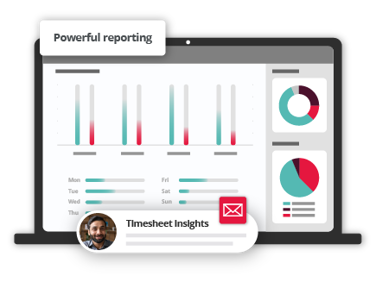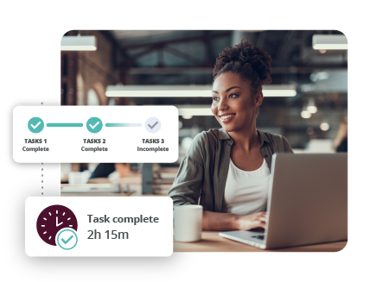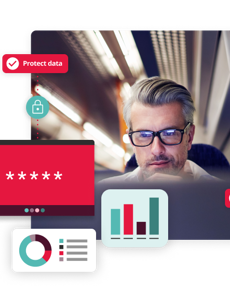What is a timesheet & how does it work

What is a timesheet?
A timesheet is a helpful data table that allows businesses to track and record the time a particular employee has worked during a specific period or spent on a particular project. This can be done via paper, a digital spreadsheet or through designated time-tracking software.
Timesheet management is vital to many areas of the business, as it helps to facilitate efficient workforce management, payroll processing, and strategic decision-making.

How do timesheets work
A timesheet works by employees logging their work hours through manual entry or by clocking in and out using specialised apps or software. This process involves recording the start and end times of each workday, along with any breaks or periods of absence. Employees may update their timesheets to reflect different tasks or projects worked on during specific time intervals, providing detailed insights into their productivity and contributions.
These are then used by HR teams for various purposes, such as weekly reviews to track employee work hours, tasks completed, and any deviations from the established schedules, or at the end of each pay period to ensure accurate calculation of wages, overtime, and benefits.
There are several ways in which employees can fill in their timesheets, these include:
- Paper-based systems
Whilst most paper-based systems are being replaced by more modern digital software solutions, some small to medium businesses still choose to use punch cards and paper-based registers.
- Spreadsheet software
Spreadsheet software such as excel proves a popular choice of timesheet solutions, thanks to their tabular nature. Employees can fill in spreadsheets by manually entering their work hours and tasks into designated cells or fields. Typically, they input start and end times for each workday, along with any breaks or periods of absence. You can access an array of templates online, to help you get started.
- Purpose-built time-tracking software
Whilst time-tracking software systems can be expensive, they offer great functionality and many benefits for SMBs. With timesheet software, employees can clock in and out of work via a mobile or web app, allowing you, the HR professional, and your employees to keep track. Timesheets such as these also include a full authorisation process, analysis tools and comprehensive reports at the click of a button.
By streamlining time tracking and reporting, timesheets can play a crucial role in maintaining organisational transparency and accountability, while also optimising resource allocation and workforce management.
Who uses a timesheet?
Timesheets are used by various stakeholders within an organisation. Primarily, businesses across all industries rely on them as a legal requirement to track employee work hours for payroll and compliance purposes.
However, the usage extends beyond regulatory obligations. Employees themselves can use timesheets to monitor their attendance, record their completed tasks, and track client interactions, fostering accountability and productivity. Additionally, HR departments can leverage this data to gain more HR data insights into workforce productivity, analyse project timelines, and identify trends for strategic decision-making.

What is timesheet software?
Timesheet software refers to a digital tool or software designed to streamline the process of managing and tracking employee work hours, tasks, and projects. It provides a centralised platform where employees can electronically submit them. It enables businesses to efficiently collect, organise, and analyse time-related data, improving accuracy and reducing administrative overhead associated with traditional paper-based methods.
Moreover, it offers features that enhance flexibility and scalability for businesses of all sizes and industries, such as:
- Customisable reporting
- Integration with payroll systems
- Mobile accessibility via self service
In the realm of timesheet software, a range of options exists to fit your needs and preferences. These software solutions vary in functionality, ranging from basic time tracking to more advanced features like:
- Project management integration
- Invoicing capabilities
- Employee scheduling tools.
Depending on the specific requirements and priorities of your business, you can choose from an array of timesheet software options available in the market, ensuring that you find a solution that aligns with your business's operational workflows and objectives.

Why timesheets are used in business
As previously mentioned, timesheets play a crucial role in the smooth functioning of businesses, serving as a fundamental tool for tracking employee work hours, tasks, and projects. Beyond legal compliance, they offer invaluable benefits that enhance organisational efficiency and effectiveness.
One of the primary reasons businesses use timesheets is to ensure accurate payroll processing. By recording employee hours worked, they provide essential data for calculating wages, overtime, and bonuses, thereby minimising errors and ensuring employees are compensated fairly.
Timesheets are also intricately linked to other aspects of HR management, such as timekeeping at work, absence management and holiday entitlement. Through accurate time tracking businesses can monitor lateness and absenteeism, as well as determine employee leave balances, manage vacation requests, and ensure compliance with regulations regarding paid time off.
They also offer insights into employee productivity and allow businesses to track time to specific clients. Access to valuable information such as this will enable your business to optimise workflows, identify areas for improvement, and make informed decisions regarding project management and resource allocation.
The advantages of timesheets & timesheet software
There are many advantages to using timesheets, including increased accuracy amongst billing, payroll and data input, improved project management and efficiency, and reduced risk of errors and employee time-wasting. Let’s look at each of these advantages in more detail...
1. Accurate billing and payroll
Timesheets and timesheet software are instrumental in ensuring the accuracy of both employee wages and client bills. By meticulously tracking time spent on tasks and projects, businesses can provide transparent and verifiable records to clients, instilling trust and confidence in the billing process. Clients can be rest assured that they’ are being billed accurately for the services rendered, thereby creating positive relationships and enhancing client satisfaction.
When it comes to payroll, timesheet software often integrates seamlessly with payroll systems, allowing for the direct transfer of time data into payroll calculations. This integration minimises errors and discrepancies in wage calculations, ensuring that employees are compensated fairly and accurately for their work. Without accurate timesheets, discrepancies in wages can easily arise, leading to disputes and potential legal issues.
2. Better project management
Timesheets play a pivotal role in enhancing project management by providing granular insights into time allocation and how businesses utilises their resources. With detailed records of employee work hours and task completion, employers can accurately assess how much time specific tasks require, allowing for more realistic project planning.
By analysing timesheet data, you can identify potential bottlenecks and inefficiencies, enabling you to make informed decisions regarding workflows and improve overall efficiency. They also help facilitate continuous improvement in project management processes by serving as a feedback mechanism.
By comparing estimated versus actual time spent on tasks, employers can refine project timelines, adjust resource allocation strategies, and implement measures to enhance productivity and streamline project execution. Thus, timesheets empower businesses with valuable data-driven insights that enable better decision-making and more effective project management practices.
3. Automation means improved efficiency
Timesheet software revolutionises efficiency through automation, streamlining time tracking processes and minimising errors associated with manual data entry. With features such as mobile accessibility, employees can conveniently track their work hours and tasks from anywhere using their smartphones, eliminating the need for cumbersome paperwork or manual input.
Integration with clocking-in systems further enhances accuracy by automatically recording employee clock-in and clock-out times, ensuring precise time tracking without the risk of human error. For instance, the comprehensive time-tracking software offers timesheet functionality that saves time through automation. It allows employees to clock in and out electronically, directly feeding the time data into the timesheet system.
4. Reduces errors and time wasting
Timesheet software can help prevent errors within billing and payroll processes. By accurately tracking work hours and tasks, businesses can minimise billing discrepancies and ensure that employees are compensated correctly for their time. The software also helps remove room for errors such as typos and incorrect entries thanks to built-in validation protocols.
Software such as this can also encourage productivity amongst employees by providing transparency, accountability, and actionable insights into their work habits. By creating a tangible record of work hours and accomplishments, employees are more inclined to stay focused and disciplined in their work.
Improve your business with timesheet software
Now that we have explored timesheets, and their pivotal role in business, you will hopefully understand that adopting timesheet software can significantly enhance your business operations and productivity. By leveraging the features and functionalities of this software, such as accurate time tracking, streamlined payroll processing, and improved project management, businesses can optimize resource allocation, minimize errors, and foster a culture of transparency and accountability.
While physical timesheets remain effective, they are perceived as outdated and typically lack the autonomy and flexibility offered by timesheet software solutions.
Access PeopleHR is a fully integrated HR system featuring cloud-based timesheet software, covering every aspect of timesheet management. From a simple clocking in and out system that you can access wherever and whenever you want via the mobile and web app, to tracking specific projects and tasks, whilst browsing real-time data feeds, there are a range of options to suit your business needs.
If you’re interested in learning about how Access PeopleHR works, you can arrange a free trial at any time. We’re always happy to provide helpful guidance – even if you decide we’re not a good fit for each other.

Testimonial
Related resources
We are trusted by experts














































